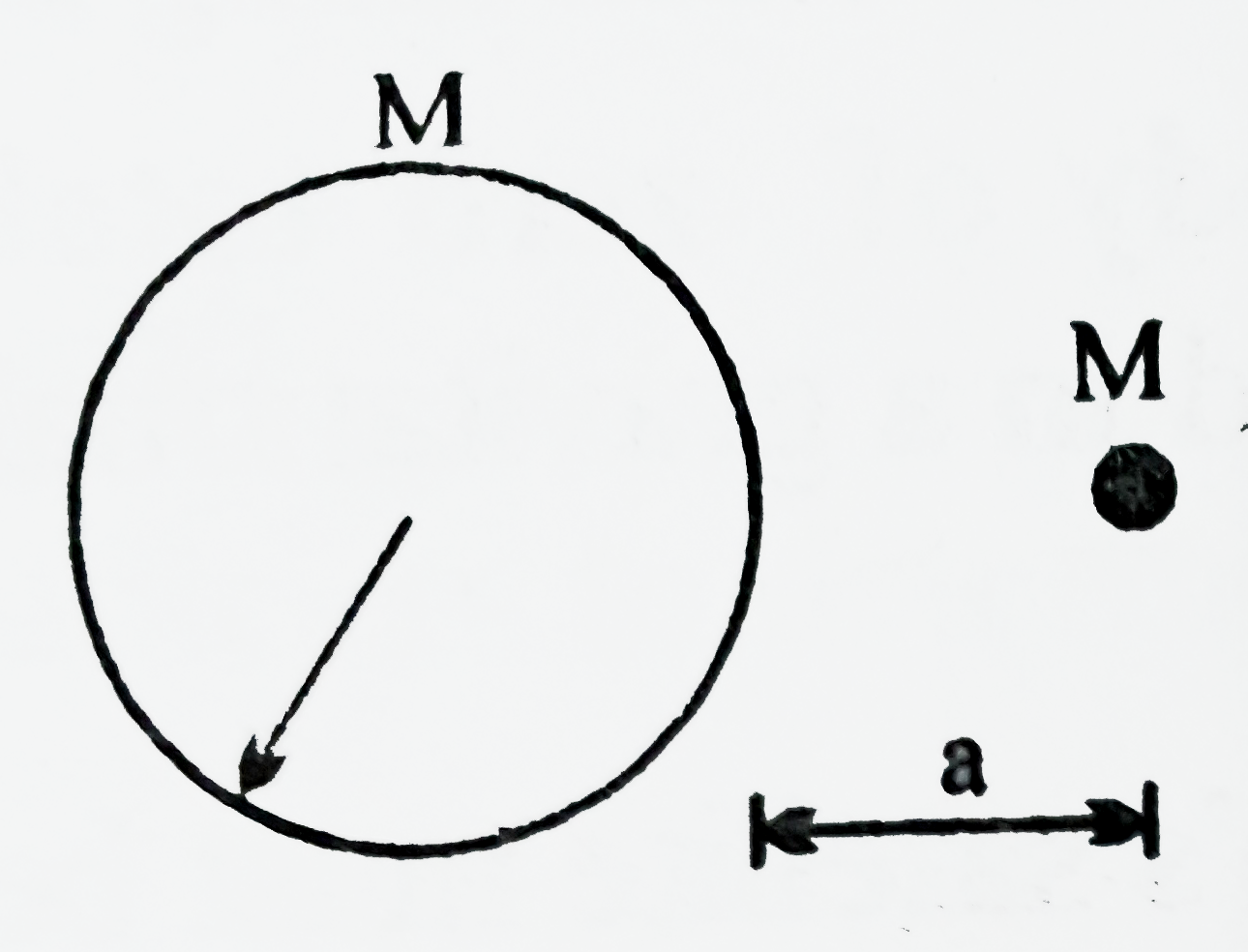Two particles, each of mass m, are a distance d apart. To bring a third particle, also having mass m, from far away to the point midway between the two particles an external agent does work given by:
4Gm2/d
−4Gm2/d
4Gm2/d2
−4Gm2/d2
The correct Answer is:B
To solve the problem, we need to calculate the work done by an external agent to bring a third particle of mass m from far away to the midpoint between two other particles, each of mass m, which are separated by a distance d.
1. Identify the Initial Configuration:
- We have two particles, each of mass m, separated by a distance d.
- The gravitational potential energy U between two masses is given by the formula:
U=−Gm1m2r
- For our two particles, the initial potential energy Uinitial is:
Uinitial=−Gmmd=−Gm2d
2. Calculate the Final Configuration:
- When the third particle of mass m is brought to the midpoint between the two particles, the distances from the third particle to each of the other two particles are d2.
- The potential energy contributions from the third particle to each of the two particles are:
U1=−Gmmd2=−2Gm2d
- Since there are two such contributions (one from each particle), the total potential energy Ufinal when the third particle is at the midpoint is:
Ufinal=−Gm2d+U1+U2=−Gm2d−2Gm2d=−5Gm2d
3. Calculate the Work Done by the External Agent:
- The work done W by the external agent is equal to the change in potential energy:
W=Ufinal−Uinitial
- Substituting the values we found:
W=−5Gm2d−(−Gm2d)=−5Gm2d+Gm2d=−4Gm2d
Final Answer:
The work done by the external agent is:
W=−4Gm2d
- We have two particles, each of mass m, separated by a distance d.
- The gravitational potential energy U between two masses is given by the formula:
U=−Gm1m2r
- For our two particles, the initial potential energy Uinitial is:
Uinitial=−Gmmd=−Gm2d
- When the third particle of mass m is brought to the midpoint between the two particles, the distances from the third particle to each of the other two particles are d2.
- The potential energy contributions from the third particle to each of the two particles are:
U1=−Gmmd2=−2Gm2d
- Since there are two such contributions (one from each particle), the total potential energy Ufinal when the third particle is at the midpoint is:
Ufinal=−Gm2d+U1+U2=−Gm2d−2Gm2d=−5Gm2d
- The work done W by the external agent is equal to the change in potential energy:
W=Ufinal−Uinitial
- Substituting the values we found:
W=−5Gm2d−(−Gm2d)=−5Gm2d+Gm2d=−4Gm2d
The work done by the external agent is:
W=−4Gm2d
Topper's Solved these Questions
- BOOK - VMC MODULES ENGLISHCHAPTER - GRAVITATIONEXERCISE - Level-230videos
GRAVITATION
- BOOK - VMC MODULES ENGLISHCHAPTER - GRAVITATIONEXERCISE - JEE Main (Archive)43videos
GRAVITATION
- BOOK - VMC MODULES ENGLISHCHAPTER - GRAVITATIONEXERCISE - LEVEL -0 Long Answer Type3videos
GRAVITATION
- BOOK - VMC MODULES ENGLISHCHAPTER - GASEOUS STATE & THERMODYNAMICSEXERCISE - JEE ADVANCED (ARCHIVE )111videos
GASEOUS STATE & THERMODYNAMICS
- BOOK - VMC MODULES ENGLISHCHAPTER - INTRODUCTION TO VECTORS & FORCES EXERCISE - JEE Advanced ( ARCHIVE LEVEL-2)12videos
INTRODUCTION TO VECTORS & FORCES
Similar Questions
Knowledge Check
- Question 1 - Select One
The reduce mass of two particles having masses m and 2 m is
A2 mB3 mC2 m/3Dm/2
The masses and radii of the Earth and the Moon are M1,R1andM2,R2 respectively. Their centres are at a distance d apart. The minimum speed with which a particle of mass m should be projected from a point midway between the two centres so as to escape to infinity is ........
View SolutionTwo particles each of mass m are connected by a light inextensible string and a particle of mass M is attached to the midpoint of the string. The system is at rest on a smooth horizontal table with string just taut and in a straight line. The particle M is given a velocity v along the table perpendicular to the string. Prove that when the two particles are about to collide :
(i) The velocity of M is Mv(M+2m)
(ii) The speed of each of the other particles is (√2M(M+m)(M+2m))v.View SolutionThe masses and radii of the earth an moon are M1andR1andM2,R2 respectively. Their centres are at a distacne d apart. Find the minimum speed with which the particle of mass m should be projected from a point mid-way between the two centres so as to escape to infinity.
View SolutionTwo bodies of mass M and 4M kept at a distance y apart. Where should a small particle of mass m be placed from M so that the net gravitational force on it is zero
View SolutionTwo stationary particles of masses M1 and M2 are 'd' distance apart. A third particle lying on the line joining the particles, experiences no resultant gravitational force. What is the distance of this particle from M1 ?
View SolutionEach of the four corners of a square with edge a is occupied by a point mass m. There is a fifth mass, also m, at the center of the square. To remove the mass from the center to a point far away the work that must be done by an external agent is given by:
View SolutionConsider a system of two particles having masses m1 and m2. If the particle of mass m1 is pushed towards the centre of mass of particles through a distance d, by what distance would the particle of mass m2 move so as to keep the mass centre of particles at the original position?
View Solution

